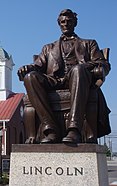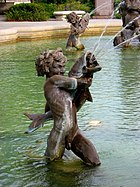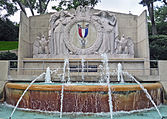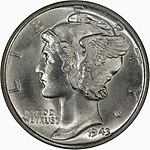Adolph Alexander Weinman
Adolph Alexander Weinman | |
|---|---|
 Adolph Weinman, c. 1917 | |
| Born | December 11, 1870 Durmersheim, Baden, Germany |
| Died | August 8, 1952 (aged 81) Port Chester, New York, U.S. |
| Nationality | German-American |
| Education | |
| Known for | Sculpture |
Adolph Alexander Weinman (December 11, 1870 – August 8, 1952) was a German-born American sculptor and architectural sculptor.
Early life and education

Adolph Alexander Weinman was born in Durmersheim, near Karlsruhe, Germany. He immigrated to the United States in 1885 at the age of 14.[1] At the age of 15, he attended evening classes at Cooper Union and later studied at the Art Students League of New York with sculptors Augustus Saint-Gaudens and Philip Martiny.
Career
He worked as an assistant to the sculptors
Weinman was a member of the
Death
Weinman died in
His son Robert Weinman was also a sculptor. His son Howard Weinman designed the Long Island Tercentenary half dollar commemorative coin.
Works

Despite his objections, Weinman is still best remembered as the designer of the
Weinman's work as an architectural sculptor can be found on the
Weinman's non-architectural works include the Macomb and the Maybury monuments in
Weinman collaborated with Polish American sculptor Joseph Kiselewski to create a sculpture on the Bronx County Court House in New York City in the early 1930s.[10]
Weinman was one of 250 sculptors who exhibited in the 3rd Sculpture International held at the Philadelphia Museum of Art in the summer of 1949.
Weinman's works are mostly executed in a lyrical neoclassical style. His figures typically wear classical drapery, but there is a fluidity found in his work that is a harbinger of the Art Deco style that was to follow him. His bronze statuette The Nude Golfer epitomizes this style. This work evokes classical sculpture in its attention to anatomy and movement and the nude status of the athlete while the subject, a modern golfer, provides a modern twist.[11]
Weinman also taught; among his pupils was Eleanor Mary Mellon.[12]
Selected works
Sculpture
- General Alexander Macomb (1906–1908), Detroit, Michigan.[8][13][14]
- Union Soldiers and Sailors Monument (1909), Wyman Park, Baltimore, Maryland.
- Abraham Lincoln (1909), Hodgenville, Kentucky. A replica of this is at the University of Wisconsin–Madison.
- Pennsylvania Station, New York City.[2]
- Abraham Lincoln (1911), Kentucky State Capitol, Frankfort, Kentucky.
- William Cotter Maybury Memorial (1912), Grand Circus Park, Detroit, Michigan.
- Rising Sun (1914–15), Panama–Pacific International Exposition, San Francisco, California.
- Descending Night (1914–15) (model, Audrey Munson), Panama–Pacific International Exposition, San Francisco, California.
- Samuel Rea (1926), Pennsylvania Station, New York City.[2]
- Fountain of the Centaurs (ca. 1926), Missouri State Capitol, Jefferson City, Missouri.
- Pair of Lions (1929–30), Baltimore Museum of Art, Baltimore, Maryland.
- Dewitt Clinton (1941) and Alexander Hamilton (1941), Museum of the City of New York, New York City.
- Riders of the Dawn (ca. 1942), Brookgreen Gardens, Murrell's Inlet, South Carolina.
-
Baltimore, Maryland
-
Abraham Lincoln (1909)
Hodgenville, Kentucky -
Pennsylvania Station
New York City -
William Cotter Maybury Memorial (1912), Grand Circus Park,
Detroit, Michigan
-
Civic Fame (1913), atop Manhattan Municipal Building,
New York City -
Descending Night (1914–15), Panama–Pacific International Exposition,
San Francisco -
Samuel Rea (1926),Pennsylvania Station,
New York City. -
One of the four Adolf Weinman eagles of the Prison Ship Martyrs' Monument
-
One of four bronze eagle sculptures surrounding the Prison Ship Martyrs' Monument in the Fort Greene Historic District
Architectural sculpture
- Architectural sculpture (1903–04), McKim, Mead and White, architects, (demolished 1964). Salvaged pieces of statuary survive in multiple locations.
- Architectural sculpture (1904–1906), McKim, Mead and White, architects, (demolished 1919).
- Architectural sculpture (1908), McKim, Mead and White, architects.
- Masonic Sphinxes: Power and Wisdom (1911–1915), House of the Temple, Washington, D.C., John Russell Pope, architect.
- Architectural sculpture (1913–1915), McKim, Mead and White, architects.
- Bronze doors (1921–1923), American Academy of Arts and Letters administration building, West 155th Street, Audubon Terrace, Manhattan, New York City.
- Architectural sculpture (1924–1926), Elks National Veterans Memorial, Chicago, Illinois.
- Architectural sculpture: South Pediment (ca. 1926), Missouri State Capitol, Jefferson City, Missouri.
- Architectural sculpture: Destiny Pediment (1935), National Archives Building, Washington, D.C.
- Drafting the Declaration of Independence (1939–1943), pedimental sculpture honoring the Committee of Five on the Jefferson Memorial, Washington, D.C.
-
Pennsylvania Station, New York City (1903–04, demolished 1964)
-
Eagle Scout Memorial Fountain (1968), Kansas City, Missouri. Salvaged pieces fromPennsylvania Station,
New York City -
Eagle,Pennsylvania Station,
New York City -
Eagle (1908), one of four that decorated theBrooklyn, New York City
-
Detail, bronze doors, American Academy of Arts and Letters West 155th Street entrance, (1921–1923)
New York City -
The Glory of Peace Frieze (1924–1926),Chicago, Illinois
-
Destiny Pediment (1935), National Archives Building,
Washington, D.C. -
Drafting the Declaration of Independence Pediment (1939–1943), Jefferson Memorial,
Washington, D.C.
U.S. coins and medals
- 1904 World Fair, Louisiana Purchase Exposition award Medals The obverse of the medal depicts two female figures above the date MCMIV (1904). The tall taller figure is Columbia, with her arms spread wide holding the United States flag. The youthful maiden at her side represents the Louisiana Purchase Territory. Emblematic of her reception into the union, the maiden is divesting herself of the cloak of France, the material decorated with bees, the emblem of Napoleon. In the background is the rising sun, marking the dawn of a new era of progress to the nation. Encircling the two figures are the words “Universal Exposition – Saint Louis – United States of America.”
[15] The reverse shows an architectural tablet inscribed with “Gold Medal” and “Louisiana Purchase Exposition”. Below the tablet are two dolphins symbolizing the nations’ eastern and western boundaries, the Atlantic and Pacific oceans. Above the tablet is a large eagle with its wings spread. The inscription reads “Gold Medal (Silver and Bronze Medals were also given out) Louisiana Purchase Exposition 1904”. In addition to the medal a diploma of award was also given to the recipient. The medal weights approximately 3.5 ounces.
- Mercury dime (1916–1945). More than two billion Mercury dimes were minted before it was replaced by the Roosevelt dime in 1946.[16] The design is now used as the obverse of the American Palladium Eagle coin, which has been produced since 2017.
- Walking Liberty half dollar (1916–1947). Replaced by the Franklin half dollar (1948). Weinman's carving is now used as the obverse of the American Silver Eaglecoin, which has been produced since 1986.
- J. Sanford Saltus Medal Award – awarded by the American Numismatic Society. Weinman was the second recipient of this medal.
References
Notes
- ^ 1910 U.S. Census, New York City.
- ^ a b c d "About the Adolph A. Weinman Papers". Smithsonian Archives of American Art. Retrieved March 27, 2010.
- ^ Reiter, Ed (January 31, 2000). "The Weinman Legacy–Part 1". PCGS Library. Archived from the original on May 16, 2011. Retrieved March 27, 2010.
- ^ "Descending Night". www.metmuseum.org. Retrieved December 30, 2022.
- ^ "Adolph Alexander Weinman". Olympedia. Retrieved July 29, 2020.
- ^ Luebke, Thomas E. (ed.) Civic Art: A Centennial History of the U.S. Commission of Fine Arts (Washington, D.C.: U.S. Commission of Fine Arts, 2013): Appendix B, p. 557.
- ^ One is illustrated in Walsh, Kevin. Forgotten New York: The Ultimate Urban Explorer's Guide to All Five Boroughs, 2006:169: "Others can be found in Kings Point and Hicksville and as far away as Philadelphia".
- ^ a b Zacharias, Pat (September 5, 1999). "The Monuments of Detroit". The Detroit News. Archived from the original on July 10, 2012. Retrieved March 27, 2010.
- ISBN 0813108659. Retrieved November 24, 2013.
- ^ "Sculpture". Joseph Kiselewski. Retrieved May 4, 2023.
- ^ "Adolph Alexander Weinman". Fine Art, May 2007. Rago Arts and Auction Center. Archived from the original on July 15, 2011.
- ISBN 978-1-135-63882-5.
- ^ "Statue of General Alexander Macomb". January 4, 2009. Retrieved March 27, 2010.
- ^ Lloyd, Marshall Davies (August 20, 2006). "Navarre Arms: The Navarres of Meaux and New France". Retrieved August 3, 2016.
- ^ "1904 St. Louis World's Fair Medals: Louisiana Purchase Exposition Collectibles". January 12, 2024. Retrieved February 16, 2024.
- ISBN 978-1-880731-17-8.
Bibliography
- Kvaran and Lockley, A Guide to the Architectural Sculpture of America, unpublished manuscript
External links
- Works by or about Adolph Alexander Weinman at Internet Archive
- Adolph A. Weinman Papers at the Smithsonian Archives of American Art
- Artist page at the Metropolitan Museum of Art
- Adolph Weinman - Master Engraver
- A.A. Weinman (1870-1952) at the R. W. Norton Art Gallery
- Adolph Alexander Weinman at Find a Grave

























